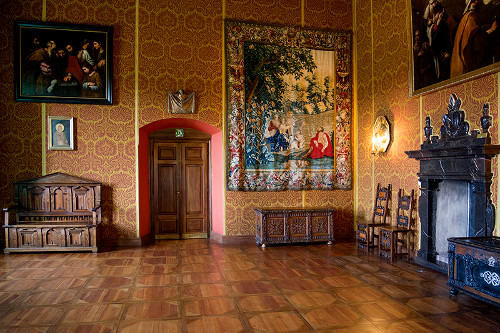 The permanent exhibition is organized on the first floor of the 17th-century Cracow Bishops’ Palace. One may see there precious decorative arts objects and a unique set of portraits of the representatives of Polish gentry in the Upper Hall.
The permanent exhibition is organized on the first floor of the 17th-century Cracow Bishops’ Palace. One may see there precious decorative arts objects and a unique set of portraits of the representatives of Polish gentry in the Upper Hall.
Another valuable element of decoration is huge French tapestry from the half of 18th c. made according to the painting by famous Charles Le Brun - “The Battle of Alexander the Great with Persians at the Granicus River”. In the same chamber we may also admire German furniture of an extraordinary artistic class level – a pair of inlaid dowry chests (Franconia, 1580-1590) with excellent inlaid decoration, a hunter’s chest (beginning of the 17th c.), two hall wardrobes (Frankfurt, 17th/18th c.), and finally, a south German wardrobe with rich figural, animal and floral inlay (1st half of the 18th c.). There is also a so-called Gotic chair from Sancygniów with Dębno coast of arms, the monogram HK of its author (Hans Kuntz from Cracow) and the date 1588.
The upper dining room is the most magnificent room in the palace - 6,8 m height and the area of almost 200m2. The ceiling consists of 21 larch beams; it is all painted with allegorical scenes, four seasons, months, symbols, geometrical and floral patterns.
Above windows there are 3 coats of arms - of Jakub Zadzik (the Korab- kind of a boat), of the Crown (the Vasa dynasty’s Eagle with a Sheaf) and the Cracow chapter (the Three Crowns). On both sides of the Eagle there are portraits of two Polish kings - Sigismund III (on the left) and Ladislaus IV (on the right). In the left corner – hardly recognisable portrait of Zadzik. Around the room there is a double mural presenting 56 effigies of Cracow bishops. In the chamber we may also see some examples of the northern European furniture: Dutch double door cupboard, Hamburg hall wardrobe, richly carved and inlaid cupboard from 1623 and a set of Gdańsk furniture from the turn of 17th and 18th century: a table with coats pf arms of Gdańsk and Polish Commonwealth, a hall wardrobe and a wardrobe cabinet with elaborate details and a unique table-cloth press with figural decoration. One door wardrobe with a broken ledge (1st half of the 18 c.) probably comes from the area near Bytów or Lębork. On the table there is a silver rococco punch bowl from the mid-18th c., a work made in unknown goldsmith workshop from the South-Eastern Lesser Poland (Lvov?).
In the southern part of the palace there used to be apartments of its owners – bishops. Bishops’ apartment consisted of two antechambers, a bedroom and a private study.
In the antechamber the guests awaited for the audience with a bishop. The room distinguished its rich decoration and furnishings. There used to be a frame ceiling by Tommasso Dolabella presenting scenes from the Polish-Moscow wars (17th c.). However, as the result of the war was unhappy for the Russian, in the 19th c. when they invaded Poland, the ceiling was removed and has never come back to its place. The old interior decorations that have survived until the present day includes a marble fireplace with the Korab and some relics of the marble floor. The ceiling frame and window frames have been reconstructed. On the walls, once covered with gilt and painted cordovan, at present are covered with red and gold fabric inspired by the Italian pattern from the years 1600 – 1620.
Fragments of the original marble floor are preserved in the left window jamb. In the 18th century the marble floor was replaced by the wooden one – some fragments seen near the fireplace. There is also a Brussels tapestry with the representation of the Holy Family from the workshop of Henrik Reydams Jr. (second part of 18th century) and paintings from the 17th-century Italian schools presenting scenes from the Old and the New Testament: “Judith with the Head of Holophornes” by Franciszek Smuglewicz according to Cristofano Allori; above the fireplace “Joseph Sold by his Brothers”, “Lady with Pearl” (“Toilet of Esther or Bethsabe?” from the 17th c. and “Still Life” by Francesco Fieravino, called Il Maltese. Furnishing from the 17th c.: two French wardrobes with allegories of virtues, Italian chests, including bench-chest so-called “cassapanca” and especially valuable inlaid chest from the workshop of a wood-carver from Greater Poland – Brother Hilarion. Furnishing is also complemented with various kinds of chairs and stools.








